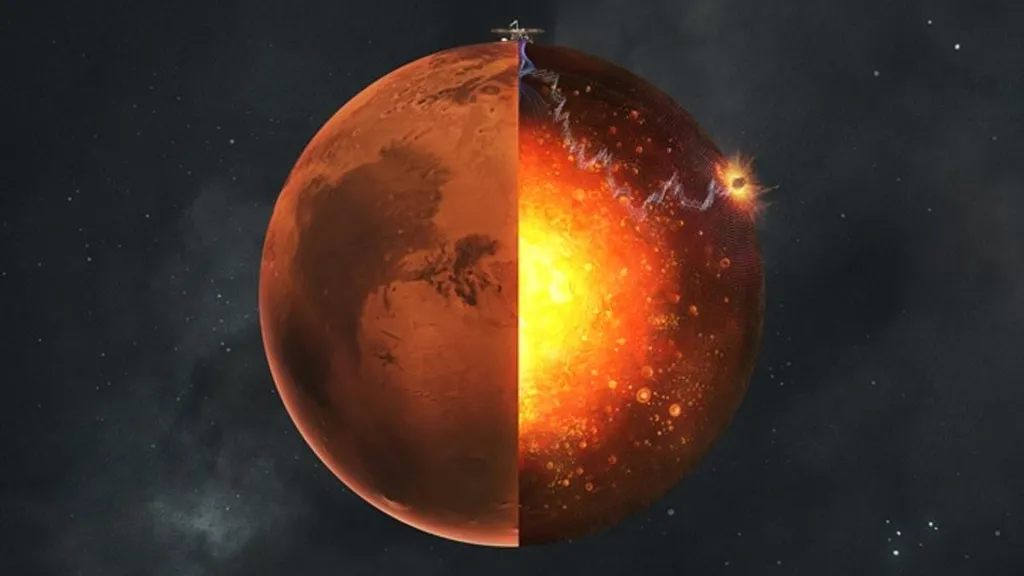If you haven't had your dinner yet, look away now.
A mouth-watering new study has revealed exactly what the interior of Mars looks like - with scientists comparing the structure to a Rocky Road.
Until now, it has been widely assumed that the inside of Mars is smooth and uniform.
In fact, scientists have suggested the planet's crust, mantle, and core are stacked like the biscuit base, caramel, and chocolate of a neat slice of Millionaire's Shortbread.
However, data collected by NASA's InSight mission reveals that this isn't actually the case.
Instead, the Red Planet's mantle is rather messy, according to experts from Imperial College London.
Rock fragments measuring up to 2.5 miles (4km) wide are dotted throughout the interior - much like the marshmallows and biscuit pieces in a Rocky Road.
These ancient fragments are 'preserved like geological fossils from the planet's violent early history,' according to the team.
A mouth-watering new study has revealed exactly what the interior of Mars looks like - with scientists comparing the structure to a Rocky Road
Rock fragments measuring up to 2.5 miles (4km) wide are dotted throughout the interior - much like the marshmallows and biscuit pieces in a Rocky Road
We already know that Mars formed about 4.5 billion years ago, as dust and rock orbiting the young Sun gradually clumped together.
Once Mars was almost fully formed, it was struck by giant, planet-sized objects in a series of 'near-cataclysmic collisions.'
'These colossal impacts unleashed enough energy to melt large parts of the young planet into vast magma oceans,' said lead researcher Dr Constantinos Charalambous.
'As those magma oceans cooled and crystallised, they left behind compositionally distinct chunks of material - and we believe it's these we're now detecting deep inside Mars.'
These impacts mixed fragments of Mars' early crust and mantle into the molten interior.
Then, as Mars cooled, these ancient chunks became trapped in the mantle - like the marshmallows and biscuit in a Rocky Road mix.
Finally, Mars sealed up its stagnant outer crust, leaving the ancient chunks trapped inside.
'Most of this chaos likely unfolded in Mars's first 100 million years,' says Dr Charalambous.
We already know that Mars formed about 4.5 billion years ago, as dust and rock orbiting the young Sun gradually clumped together. Once Mars was almost fully formed, it was struck by a giant, planet-size objects, in a series of 'near-cataclysmic collisions'
Scientists have previously suggested Mars' crust, mantle, and core are stacked like the biscuit base, caramel, and chocolate of a neat slice of Millionaire's Shortbread
How did Mars form?
We already know that Mars formed about 4.5 billion years ago, as dust and rock orbiting the young Sun gradually clumped together.
Once Mars was almost fully formed, it was struck by a giant, planet-sized objects, in a series of 'near-cataclysmic collisions.'
These impacts mixed fragments of Mars' early crust and mantle into the molten interior.
Then, as Mars slowly cooled, these ancient chunks became trapped in the mantle - like the marshmallows and biscuit in a Rocky Road mix.
Finally, Mars sealed up its stagnant outer crust, leaving the ancient chunks trapped inside.
'The fact that we can still detect its traces after four and a half billion years shows just how sluggishly Mars's interior has been churning ever since.'
In their new study, the team analysed seismic data collected by NASA's InSight lander.
As suspected, the data confirmed that the interior of Mars is chunky rather than smooth.
'What happened on Mars is that, after those early events, the surface solidified into a stagnant lid,' Dr Charalambous said.
'It sealed off the mantle beneath, locking in those ancient chaotic features -- like a planetary time capsule.'
The ancient chunks detected inside Mars follow a 'striking' pattern, according to the experts.
A few large fragments, measuring roughly 2.5 miles (4km) wide, are surrounded by many smaller ones.
Professor Tom Pike, who worked with Dr Charalambous to unravel what caused these chunks, said: 'What we are seeing is a 'fractal' distribution, which happens when the energy from a cataclysmic collision overwhelms the strength of an object.
'You see the same effect when a glass falls onto a tiled floor as when a meteorite collides with a planet: it breaks into a few big shards and a large number of smaller pieces. It's remarkable that we can still detect this distribution today.'
The researchers hope the findings will help to unravel the mystery of not only how Mars formed but also the other planets in our solar system.
'InSight's data continues to reshape how we think about the formation of rocky planets, and Mars in particular,' said Dr Mark Panning of NASA's Jet Propulsion Laboratory in Southern California.'
'It's exciting to see scientists making new discoveries with the quakes we detected!'
MARS: THE BASICS
- Mars is the fourth planet from the sun, with a 'near-dead' dusty, cold desert world with a very thin atmosphere.
- Mars is also a dynamic planet with seasons, polar ice caps, canyons, extinct volcanoes, and evidence that it was even more active in the past.
- It is one of the most explored planets in the solar system and the only planet humans have sent rovers to explore.
- One day on Mars takes a little over 24 hours and a year is 687 Earth days.
Facts and Figures
- Orbital period: 687 days
- Surface area: 55.91 million mi²
- Distance from Sun: 145 million miles
- Gravity: 3.721 m/s²
- Radius: 2,106 miles
- Moons: Phobos, Deimos
